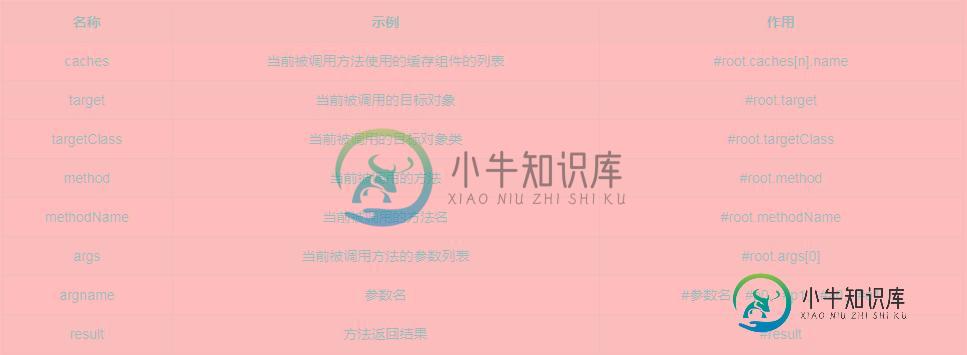Spring Boot设置并使用缓存的步骤
几个缓存注解的作用:
@Cacheable:将方法的返回结果根据key指定的键保存在缓存中,以后要获取相同的数据直接从缓存中共获取
- cacheNames/value:指定Cache组件名称
- key:指定缓存时使用的key,默认使用方法参数值,可以使用#a0、#p0、#参数名等,支持SpEL表达式,root可省略
- keyGenerator:指定key的生成器的组件id,如自定义的KeyGenerator
- cacheManager:指定缓存管理器
- cacheResolver:指定缓存解析器
- condition:指定在哪种条件下缓存,如condition = “#id>=1”在参数>=1时缓存
- unless:指定该条件为真时不缓存
- sync:指定是否使用异步模式
@CachePut:不管缓存中是否有需要的数据,都会执行该注解标注的方法,并将结果更新到缓存,属性见上
@CacheEvit:执行方法后,清除key指定的缓存
- allEntries:默认为false,值为true,删除所有缓存
- beforeInvocation:默认为false,值为true,在方法调用之前清除缓存
@CacheConfig:定义一些通用或公共的规则,如cacheNames、keyGenerator等
可使用的SpEL表达式:

使用缓存的步骤:
(1)创建一个Spring Boot应用,勾选Cache、Web、MySQL、Mybatis模块,在主程序类上添加注解,开启基于注解的缓存
@MapperScan(basePackages = "com.youngpain.cache.mapper") @SpringBootApplication @EnableCaching
(2)创建JavaBean,和数据库中的表对应,并配置数据源
spring: datasource: url: jdbc:mysql://localhost:3306/mybatis_database username: root password: 1741248769 driver-class-name: com.mysql.jdbc.Driver redis: host: 39.108.114.57 #开启驼峰命名法 mybatis: configuration: map-underscore-to-camel-case: true logging: level: com.youngpain.cache.mapper: debug
(3)创建mapper接口进行增删改查操作
/**
* 部门表的增删改查操作
*/
public interface DepartmentMapper {
@Insert("insert into department(id,depart_name,depart_build) values(#{id},#{depart_name},#{depart_build})")
void insertDepartment(Department department);
@Delete("delete from department where id=#{id}")
void deleteDepartment(Integer id);
@Update("update department set depart_name=#{departName},depart_build=#{departBuild} where id=#{id}")
void updateDepartment(Department department);
@Select("select * from department where id=#{id}")
Department getDepartmentById(Integer id);
}
(4)创建service
@Service
@CacheConfig(cacheNames = {"departs"})
public class DepartmentService {
@Autowired
DepartmentMapper departmentMapper;
@Cacheable(key = "#a0.id")
public void insertDepartment(Department department) {
departmentMapper.insertDepartment(department);
}
@CacheEvict(key = "#p0")
public void deleteDepartment(Integer id) {
departmentMapper.deleteDepartment(id);
}
@CachePut(key = "#a0.id")
public Department updateDepartment(Department department) {
departmentMapper.updateDepartment(department);
return department;
}
@Cacheable(key = "#id", condition = "#p0>=1")
public Department getDepartmentById(Integer id) {
return departmentMapper.getDepartmentById(id);
}
}
(5)创建controller
@Controller
public class DepartmentController {
@Autowired
DepartmentService departmentService;
@GetMapping("/index")
public String index() {
return "index";
}
@GetMapping("/deleteDepart/{id}")
public String deleteDepart(@PathVariable("id") Integer id, Model model) {
model.addAttribute("condition", "delete");
Department delete = departmentService.getDepartmentById(id);
model.addAttribute("department", delete);
departmentService.deleteDepartment(id);
return "success";
}
@PostMapping("/updateDepart")
public String updateDepart(Department department, Model model) {
model.addAttribute("condition", "update");
Department update = departmentService.updateDepartment(department);
model.addAttribute("department", update);
return "success";
}
@GetMapping("/getDepart/{id}")
public String getDepartmentById(@PathVariable("id") Integer id, Model model) {
model.addAttribute("condition", "delete");
Department get = departmentService.getDepartmentById(id);
model.addAttribute("department", get);
return "success";
}
}
(6)测试结果:
@Cacheable:第一次查询数据,控制台发出sql语句,之后再查询直接从缓存中获取
@CachePut:调用方法修改某个数据后,再次查询该数据是从缓存中获取的更新后的数据
@CacheEvict:调用该方法后,再次查询某个数据需要重新发出sql语句查询
ps:之前只是用markdown记笔记,今天第一次用markdown写文章,写起来好舒服啊QAQ
总结
以上就是这篇文章的全部内容了,希望本文的内容对大家的学习或者工作具有一定的参考学习价值,谢谢大家对小牛知识库的支持。如果你想了解更多相关内容请查看下面相关链接
-
本文向大家介绍SpringBoot项目中使用redis缓存的方法步骤,包括了SpringBoot项目中使用redis缓存的方法步骤的使用技巧和注意事项,需要的朋友参考一下 本文介绍了SpringBoot项目中使用redis缓存的方法步骤,分享给大家,具体如下: Spring Data Redis为我们封装了Redis客户端的各种操作,简化使用。 - 当Redis当做数据库或者消息队列来操作时,我们
-
本文向大家介绍SpringBoot下Mybatis的缓存的实现步骤,包括了SpringBoot下Mybatis的缓存的实现步骤的使用技巧和注意事项,需要的朋友参考一下 说起 mybatis,作为 Java 程序员应该是无人不知,它是常用的数据库访问框架。与 Spring 和 Struts 组成了 Java Web 开发的三剑客--- SSM。当然随着 Spring Boot 的发展,现在越来越多的
-
set 设置普通类型的值 设置 set set(key: string, value: string expiryMode: string[ EX 秒 PX 分钟 ], time: number ) key: 键名称 value:存储的值 expiryMode:添加过期时间类型 EX 秒 PX 分钟 time:过期时间 // 存储一个key为gender,value 为 男人的数据,10秒后过期
-
我试图设置本地DynamoDB实例与SpringBoot。我跟着这个,但是格拉德尔。 当我尝试运行我的应用程序时,会出现以下异常: 我知道这是由于歧义导致的依赖注入失败,但我的是一个无参数构造函数。不确定歧义在哪里。 以下是我的代码: 格雷德尔锉刀 发电机配置 代理(实体) @DynamoDBTable(tableName="Agent")公共类Agent{私有字符串代理号;私有整数id;私有企业
-
使用Spring的缓存抽象,如何让缓存异步刷新条目,同时仍返回旧条目? 我试图使用Spring的缓存抽象来创建一个缓存系统,在相对较短的“软”超时之后,缓存条目可以刷新。然后,当查询它们时,返回缓存的值,并启动异步更新操作来刷新条目。我也会 Guava的缓存生成器允许我指定缓存中的条目应该在一定时间后刷新。然后可以用异步实现覆盖缓存加载器的reload()方法,允许返回陈旧的缓存值,直到检索到新值
-
我尝试使用ARM模板配置Azure Redis缓存。这正如预期的那样工作,但我不能指定访问密钥。 通常我使用生成的密钥,这可能是推荐的方式-但在这种情况下,我不想在我的部署中提供这些密钥(出于某些遗留原因)。 Q: 是否可以在ARM模板中提供访问密钥?或者我可以在部署后使用PowerShell设置它们吗? 以下是我的ARM模板的一个片段:

